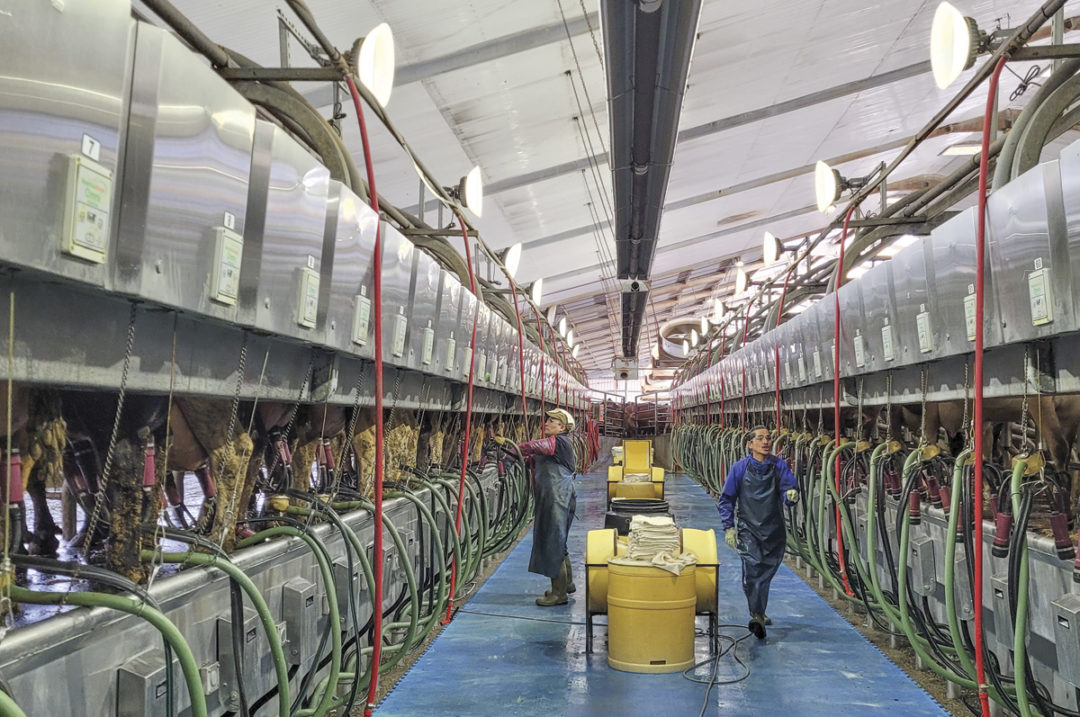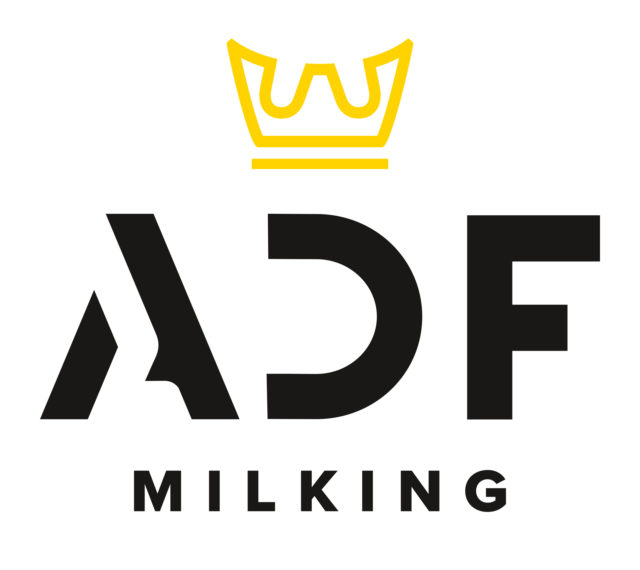Let’s be very clear – we do not use vacuum to “suck” the milk out of the cow. She must give it to us voluntarily. If we want to milk cows more gently, quickly and completely, the goal must be to improve milk flow rates through better stimulation and milk letdowns.
What is the process of milk letdown?
Milk letdown is primarily driven by a complex neuro-chemical pathway, whereby manual or tactile stimulation (touch) of the teat triggers nerve endings in the teat end to conduct a signal to the pituitary gland in the brain. In nature, this stimulation is achieved by the calf’s actions, such as the tongue action across the teat end when nursing. For the purposes of milk harvest, milking technicians provide that stimulation. In response to this nerve stimulus, the pituitary gland releases the hormone oxytocin, which is carried by the bloodstream to the udder. In the udder, oxytocin stimulates the myoepithelial – or smooth muscle – cells surrounding the alveoli that secrete the milk to contract around the alveoli. This squeezes the milk the alveoli contain into ducts that will carry the milk to the gland cistern in the base of the udder. From there, the milk will flow into the teat cistern, where it can be harvested by being allowed to flow through the teat end.
What defines "good" milk letdowns?
In its most basic form, milk letdown is about establishing and maintaining high flows of milk from each teat. In other words, milk flow starts immediately, hits a peak quickly, holds high flow throughout the attach period and ends abruptly when milk-out is complete.
Why is this important? Milk harvest uses vacuum to help create a pressure gradient beneath the teat. This allows milk to flow from the high pressure within the teat and gland created by milk letdown to the area of low pressure beneath the teat. Note – vacuum is an unnatural condition for all living tissues. To avoid the detrimental effects of exposure to vacuum, the best thing we can do is limit the time the teat is exposed to vacuum by harvesting the available milk as quickly as possible and ensuring that pulsation and liner choice are both effective.
That means maximizing milk flows from the moment we attach the unit right up until we detach the unit. Perhaps just as important, is to note that the physics of milk harvest is designed around the teat being plump and full of milk throughout milking. When the teat is not plump and full, as would be the case during bimodal milk letdowns, the milking experience is frequently uncomfortable or painful. Teats that are not full of milk lead to additional liner slips and squawks as well as falloffs or even kickoffs. This is also a significant contributor to teat rings and potentially uneven milk-out.
In terms of parlor efficiency, maximizing the milk flow rates is also the most effective way to speed up milk-out. Anyone who wants to optimize their return on their parlor fixed costs and increase efficiency should be very motivated to achieve consistent milk letdowns. Research has also shown that bimodal or delayed milk letdowns can have a long-term negative impact on milk production.
How can we practically go about assessing milk letdowns?
- Milk flow graphs: Looking at a milk flow rate graph of a well-stimulated cow, it looks like a square, with the flow rate increasing sharply as soon as the teat cups are connected, maintaining high flow rates throughout the unit-on time or duration and then declining precipitously at the end of milking before the unit is removed. These graphs can be made using a specialized unit called a lactocorder or can be obtained from many brands of milk meters. Some brands and models of detachers utilize ohms to measure milk flow. Ohms is simply the unit or scale to measure resistance to the flow of an electrical current. As milk flow increases, resistance to conduction or ohms decreases inversely. Some of the newer models of detachers that utilize this principle to determine milk flow can produce a graph of the detected ohms, or resistance to conduction, of low voltage current. Graphs of the measured resistance, made over the duration of the milking event, will typically be the inverse of the milk flow rate, so they can be used as a proxy to look at the milk flow rate over the period the unit is attached.
- Milk meters: Milk meters provide additional metrics to observe. Since the outcome of milk letdown is milk flow, logically, that is the first place to start. Milk volume harvested in the first two minutes is perhaps the best pure indicator of milk letdown success. I have the pleasure of working with many excellent herds that can achieve greater than 17 pounds of milk harvested in the first two minutes on 3X-milking. Herds milking 2X should achieve even higher numbers, as their cows typically will have higher udder pressure and more milk in their udders at each shift. The average flow rate incorporates two-minute milk measurements as well as sustained milk flow and the end of milk flow. Many manufacturers look at incremental flow rates, which will give you average flow rates over intervals for 0-15 seconds, 15-30 seconds and 30-60 seconds post unit attach. While it is true that these numbers can be misleading in some cases, in general, most experts agree they should be increasing over each interval if letdowns are consistent.
- Observation: For those that may not have access to meters, your metric may be as simple as watching the claw bowl or the milk hose. When you attach the claw, you should see significant milk flow streaming from each milk inlet like a jet and not a dribble that drains down the side. Visually, this flow should be consistent throughout the time the milking unit is attached to the cow. When the cow experiences bimodal milk flow, we can see less milk flow in the bowl of the claw, and in some cases, a period of no flow or minimal flow that coincides with bimodal letdowns.
- Claw vacuum: Regardless of milking equipment, we can also measure claw or short milk tube vacuum throughout the period the unit is attached to the cow. As flow rates increase, peak flow claw vacuum will typically decrease inversely. When coupled with mouthpiece chamber vacuum measurements measured in the top of the liner or inflation, we can assess when the cow establishes peak flow and if there are bimodal milk letdowns.
How can we ensure that we achieve better, more consistent milk letdowns?
-
Manual stimulation: Maximize the cow’s natural release of oxytocin by increasing the level and duration of stimulation. When we touch something with our fingers, it triggers nerve sensations that are sent to the brain. These same touch sensations occur for the cow when we touch and manipulate her teats as we work through the prep process. Just as with our fingers, the greatest concentration of nerve endings capable of being stimulated is in the tip and not the barrel of the teat. In order to maximize tactile stimulation, we need to focus on the teat end when it comes to our prep procedures.
Making a deliberate effort to consistently work the towel or brush across the end of the teat not only maximizes stimulation and milk letdowns, but it also is a way to mitigate some of the risks of new intramammary infections. Another manual tactile stimulation frequently utilized in cow prep is the use of forestripping or priming. During forestripping, the technician manually squeezes the barrel of the teat to express several streams of milk for visual inspection. The number of strips removed, and the level of vigor used to express the milk, contribute to the degree of stimulation achieved.- When possible, I coach my teams to use a two-handed stripping method, whereby one teat is held in each hand and two quarters are stripped simultaneously. This frequently leads to more vigorous forestripping without focusing on more effort from the technician. You may be surprised to know that the cow really does not care if we strip two streams of milk from each teat or eight streams of milk from one teat. Although, if you want to get the mastitis detection value out of forestripping, then we obviously want to strip all four teats.
- Another manual stimulation technique used successfully by some herds is to hold the barrel of the teat between two fingers and use the tip of the thumb to rub across the teat end before or after completing the stripping action.
- Improve timing: While we previously believed the letdown process could be completed in 60 seconds from the first stimulation, most experts now believe the process is closer to 90 seconds. This is why the current recommendation is that a prep lag time, or delay of between 60 and 90 seconds, should occur from when the teat is first manually stimulated to when the unit is attached. The goal is to properly time attachment with letdown. It is also important to remember that oxytocin has a very short half-life, meaning its concentration in the blood declines rapidly. Most of the available oxytocin will be gone within 5-6 minutes, so we have a limited window to harvest the available milk.
- Remove disruption: In nature, bovids are prey species; their instincts are ones of fight or flight. Aggressive and loud animal handling is frequently a culprit. It is especially true in our fresh heifers, where handlers may not have the calm demeanor and patience necessary to assess the situation and work with the animal. Pain is another factor. If any part of the routine or milking process induces pain, milk letdown likely will be impaired or absent. The milking process should be calm and comfortable for the cow and the technician. The cow should feel a release of udder pressure, and that should be a positive experience. We have all seen cows that run to the parlor when the gate is opened, but the opposite is also true. Cows have a good memory, and if the cow has had an unpleasant experience in the parlor it can negatively impact future milking experiences.
- Consistency: Everything we know about cows is that they crave consistency. Changes in things, such as feed and weather, often upset the proverbial apple cart, and milking is no different. The cow is extremely dependable and predictable. She responds in repetitive and consistent ways. Even if not achieved in the exact same way, we should ensure that each technician is creating significant stimulation by focusing on wiping teat ends consistently and forestripping with vigor. We must work with and coach our technicians to achieve a sufficient and consistent lag time from the first stimulating touch to unit attachment. On the flip side, bad practices, such as jumping in to help in territorial routines, not respecting planned cow spacing in follow-the-leader routines, skipping or shortchanging a stimulating step or moving a stimulating step in the routine, will have negative effects.
Improving milk harvest by valuing people
The pathway to better milk letdowns runs not through the cow but through the people. If you seek to improve milk harvest – only when the people are engaged and stimulated can the cow’s stimulation be engaged. The difference I see across teams that achieve consistently good letdowns and high flow rates and those that do not has very little to do with having better facilities, access to more knowledge or better procedures on paper. Teams that achieve success simply are better at executing the plan they have consistently.





